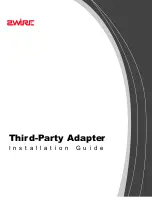
Using this Guide
1-3
Introduction to SPMA for the FRX4000, FRX6000, and SmartSwitch 1800
disabling serial ports, and so on) available only from within the Hub View are
also described. You can access the Hub View application from the icon menu
or the command line.
¥
Chapter 3,
Trap Table
, describes how to conÞgure the deviceÕs trap table,
which controls which management stations will receive traps from a selected
device. The Trap Table application is accessible from the Hub View.
¥
Chapter 4,
ConÞguring the Subscriber Table
, describes how to add, modify,
and delete entries in the subscriber table, which controls the operation of
virtual circuits across the frame relay network. You can access the Subscriber
Table application from the Hub View.
¥
Chapter 5,
Frame Relay Status and ConÞguration
, describes how to conÞgure
serial ports set to operate using the frame relay protocol (including DLCI
conÞguration); it also describes how to conÞgure logical ports and frame relay
backup groups. Frame relay-speciÞc management, congestion, and error
statistics are also described. Frame relay status and conÞguration options are
available from the Hub View.
¥
Chapter 6,
X.25 Status and ConÞguration
, describes how to conÞgure serial
ports for X.25 protocol support and provides detailed information about
management, congestion, and error statistics available on the ports. X.25 status
and conÞguration options are available from the Hub View.
¥
Chapter 7,
SNA Status and ConÞguration
, describes how to conÞgure SNA
ports and provides physical unit and link station parameters. SDLC-speciÞc
port and general statistics are also provided. SNA status and conÞguration
options are available from the Hub View.
¥
Chapter 8,
BSC Interactive ConÞguration
, describes how to conÞgure binary
synchronous communications (BSC) Interactive ports and provides BSCI
Subscriber and Device information. BSCI conÞguration options are available
from the Hub View.
¥
Chapter 9,
IP Interface ConÞguration
, describes how to conÞgure an IP
Interface to allow the Internet Protocol (IP) to be executed over a frame relay,
X.25, or LAN interface. IP Interface options are available from the Hub View.
¥
Chapter 10,
IPX Interface ConÞguration
, describes how to conÞgure an IPX
Interface to allow connections to Novell IPX networks. IPX Interface options
are available from the Hub View.
¥
Chapter 11,
Bridge ConÞguration
, describes how to set up a bridge interface
and provides detailed information on conÞguring device-level bridging
parameters. It also describes how to conÞgure frame relay and LAN bridge
ports. Bridging conÞguration options are available from the Hub View.
TIP
Since these devicesÕ trap tables contain some additional functionality not found in other
Cabletron devices, its operation is described here. Note that the
Trap Table
chapter
included in the
SPMA Tools Guide
does not apply to these devices.
Summary of Contents for SPECTRUM 1800
Page 2: ......
Page 112: ...Frame Relay Status and Configuration 5 24 Viewing Frame Relay Status...
Page 124: ...X 25 Status and Configuration 6 12 Viewing X 25 Status...
Page 168: ...BSC Interactive Configuration 8 12 Configuring BSCI Devices...
Page 224: ...SmartSwitch 1800 Voice Configuration 12 20 Viewing Voice Statistics...












































